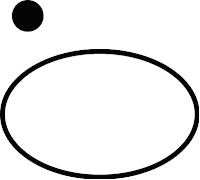 |
| Make effective connections. |
Prologue:
Learning Faster
The idea is this: the more effectively you use your time to learn something, the less time you have to spend on reviewing it (i.e. "reviewing" what you thought you knew in the first place). Here are four steps in the "Feynman Technique" (based on a post from Medium) that could help you more effectively learn an idea that is new to you:Step 1: Teach it [as if] to a child.
Step 2: Review.
Step 3: Organize and Simplify.
Step 4 (optional): Transmit.
I personally would add: Test it. Apply it.
And based on a post from LinkedIn:
When you learn something, check that you can actually do a few things.
Can you...: Understand it? Explain it? Remember it so you can use it later?
...Use it in real life?
_________________________
Now here's all of the above info, re-digested and re-combined into pictures: |
| Step 1: Link "New" Idea to "Old" Idea |
 |
| Step 2: Make a Cohesive "Story" out of the Ideas |
 |
| Step 3: "Tell" your "Story" to Someone Else |
 |
| Step 4: Use it and Test it |
_________________________
Epilogue:
Memory Structures
The structures in those pictures are quite similar to the structure of some mnemonic techniques (i.e. similar to the structures of different ways to help yourself remember things).Visually, they remind me of machine learning and neural network connections, but also can serve as "schematics" for memory and understanding.
The table below shows my visualizations of five memory techniques I've seen before (link, sub, story, peg, loci)*, plus one "new" visual I've thought up for remembering branching information (I don't really know what to call it besides "branching memory structure").
| Visuals | Examples | Example Uses | ||
|---|---|---|---|---|
|
A grocery list (milk, apples, and cash) can become a ridiculous but memorable mental image that can be described as "a cow made of apples eating grass made of money---so money doesn't grow on trees". | For lists of visualizable items. Or for "attaching" reminders to objects you'll see in your home or surroundings. | ||
|
The state of Kentucky becomes "KFC food". Or "nihao" becomes "knee how" (homophones). Or conifer tree becomes your friend Khan or Connie is suddenly made of cones (head partial homophones). Or Nevada becomes a "new Vader". | For remembering definitions or translations by turning abstract words into visualizable or concrete items. The free website Memrise "automates" this with crowd-sourced memory aids for vocabulary. | ||
|
= Substitution + Link | For a list of abstract words that are new to you. | ||
|
Make use of how numbers and letters have built-in order. "One" rhymes with "sun", two with shoe, three with tree. Or A is for Aladdin, B is for Batman, C is for Cookie monster. You then use the link method to attach items to the visuals already associated to each number/letter peg. Example: Aladdin drinking milk, Batman slicing apples, Cookie monster eating cookies shaped like money. | For longer lists where the order might matter. You can still recall and test yourself on items out of order once you establish your own pegs. Also for main ideas of a script, book, presentation, etc. | ||
|
Similar to the pegs method, but instead uses spatial memory pegs that are real-life permanent items in a room you're familiar with, and those items numbered clockwise around the room, and extending to other rooms in your house. Example in my room: 1=window, 2=bed, 3=shelf. --> Milk splat on the window, pile of apples on the bed, cash exploding out from books on the shelf. | For even longer lists. For the main ideas in a script, book, presentation, etc. You recall or practice by mentally "walking" through the numbered path in your house. | ||
|
Example: broadleaf trees can be divided into opposite-branching and alternate-branching leaves. This can be visualized as a brood Zerg having opposing claws and a tail that wags alternately back and forth. Further sub-divisions among opposite-branching trees are visualized by that opposing brood Zerg claw scratching Optimus Prime, who has a hand holding a SIMS character (simple leaf) and has a foot kicking a compound inmate (compound leaf). | For branching information, like in tree identification. |
(If you can think of a better name for the last one, let me know!)
Final thoughts:
Without scrolling up, are you able draw down on paper one thing you've just learned?
Choose just one idea and try putting it to use.
_________________________
* You can see more examples and details at:
Lorayne, Harry, and Jerry Lucas. The memory book: The classic guide to improving your memory at work, at school, and at play. Ballantine Books, 2012.
And for a 7-minute video on Sherlock's Mind Palace:
https://www.youtube.com/watch?v=3vlpQHJ09do
_________________________
LINKS TO OTHER STUFF:
Favourites
Programming
Original Art
Games





